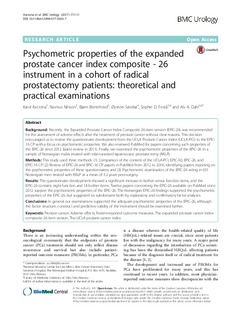| dc.contributor.author | Axcrona, Karol | |
| dc.contributor.author | Nilsson, Rasmus | |
| dc.contributor.author | Brennhovd, Bjørn | |
| dc.contributor.author | Sørebø, Øystein | |
| dc.contributor.author | Fosså, Sophie Dorothea | |
| dc.contributor.author | Dahl, Alv A. | |
| dc.date.accessioned | 2018-02-14T10:26:51Z | |
| dc.date.available | 2018-02-14T10:26:51Z | |
| dc.date.created | 2017-12-04T12:31:46Z | |
| dc.date.issued | 2017 | |
| dc.identifier.citation | BMC Urology. (2017) 17:111 | nb_NO |
| dc.identifier.issn | 1471-2490 | |
| dc.identifier.uri | http://hdl.handle.net/11250/2484575 | |
| dc.description.abstract | Background Recently, the Expanded Prostate Cancer Index Composite 26-item version (EPIC-26) was recommended for the assessment of adverse effects after the treatment of prostate cancer without clear reasons. This decision encouraged us to review the questionnaire development from the UCLA Prostate Cancer Index (UCLA-PCI) to the EPIC-16 CP with a focus on psychometric properties. We also reviewed PubMed for papers concerning such properties of the EPIC-26 since 2012 (latest review in 2011). Finally, we examined the psychometric properties of the EPIC-26 in a sample of Norwegian males treated with robot-assisted laparoscopic prostatectomy (RALP). Methods This study used three methods: (1) Comparison of the content of the UCLA-PCI, EPIC-50, EPIC-26, and EPIC-16 CP; (2) Review of EPIC-26 and EPIC-16 CP papers in PubMed from 2012 to 2016, identifying papers reporting on the psychometric properties of these questionnaires; and (3) Psychometric examination of the EPIC-26 rating in 651 Norwegian men treated with RALP at a mean of 3.2 years post-surgery. Results The questionnaire development showed a significant increase in bother versus function items, and the EPIC-26 contains eight function and 18 bother items. Twelve papers concerning the EPIC-26 available on PubMed since 2012 support the psychometric properties of the EPIC-26. The Norwegian EPIC-26 findings supported the psychometric properties of the EPIC-26, but suggested six subdomains both by exploratory and confirmatory factor analyses. Conclusions In general our examinations supported the adequate psychometric properties of the EPIC-26, although the factor structure, construct and predictive validity of the instrument should be examined further. | nb_NO |
| dc.language.iso | eng | nb_NO |
| dc.rights | Navngivelse 4.0 Internasjonal | * |
| dc.rights.uri | http://creativecommons.org/licenses/by/4.0/deed.no | * |
| dc.title | Psychometric properties of the expanded prostate cancer index composite - 26 instrument in a cohort of radical prostatectomy patients: theoretical and practical examinations | nb_NO |
| dc.type | Journal article | nb_NO |
| dc.type | Peer reviewed | nb_NO |
| dc.description.version | publishedVersion | nb_NO |
| dc.rights.holder | The Author(s). 2017 | nb_NO |
| dc.source.pagenumber | 11 | nb_NO |
| dc.source.journal | BMC Urology | nb_NO |
| dc.identifier.doi | 10.1186/s12894-017-0302-7 | |
| dc.identifier.cristin | 1522460 | |
| cristin.unitcode | 222,57,3,0 | |
| cristin.unitname | Institutt for økonomi, markedsføring og jus | |
| cristin.ispublished | true | |
| cristin.fulltext | original | |
| cristin.qualitycode | 1 | |

